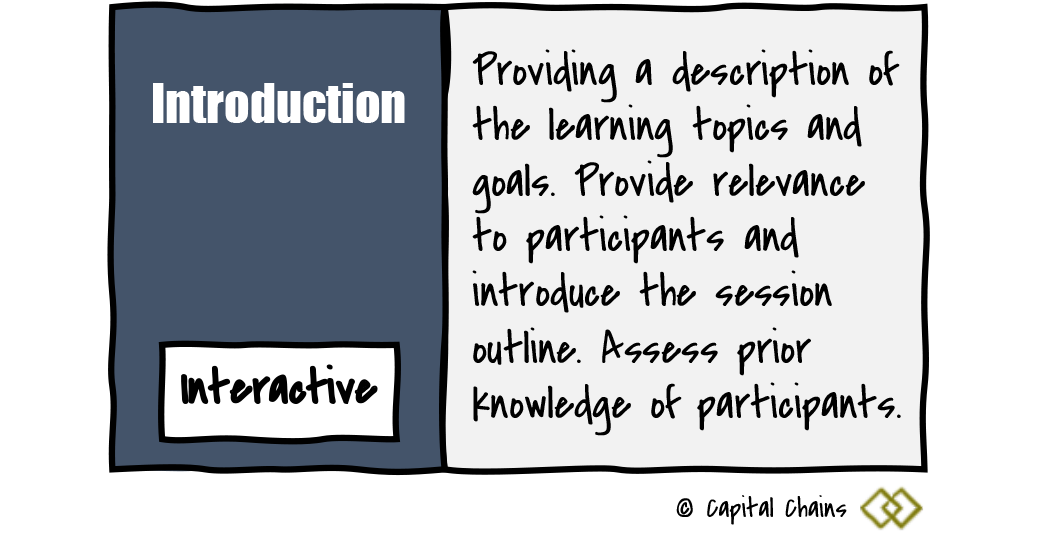
Learning Objectives
- Creating the link between Supply Chain and Finance
- Understand the levers impacting the various components of working capital in order to challenge stakeholders accountable for them
Capital Chains accelerates the provision and adoption of SCF solutions
Download Training Brochure
Training Outline – Day One

Provide a description of the topic and the main points to be covered
Introduction of participants and trainer(s)
Provide relevance to what the participants are doing in the workplace
Provide a session outline and what they will be learning
Provide assessment details
Establish what the participants already know

Provide participants with a theoretical base on working capital
Definition of working capital and calculation methods
Introducing the concept of DSO, DPO, and DIO
Focus on the impact of inventory and the role of logistics and INCO terms
- Creating a global view on the cash conversion cycle
Introducing the Economic Value Add (EVA) model as a new metric to review a company’s performance

- Optimization of working capital for the firm
- Why corporates focus more on cash instead of (only) profit
Shift from Sales and Operations Planning (S&OP) to Integrated Business Planning (IBP) which does include the finance function

- Creating the link between Supply Chain and Finance
Describing the SCF types and individual solutions
Generic (financial) benefits and associated risks of SCF solutions
High-level description of individual solution: Payables Finance
High-level description of individual solution: Dynamic Discounting
High-level description of individual solution: upon demand

- A sound SCF strategy underpins the overall Supply Chain strategy and enables a competitive advantage
Describing the internal departments involved in SCF
Aligning the internal actors, why and how

- Description of best practices around the world
Examples include setup, implementation, and roll-out
Localization of specific examples upon demand

- Evaluation of the training content of day one
- Discussing perceived impact on knowledge
Elicit summary points from participants
Introduction of learning goals for day two
Training Outline – Day Two (Business Simulation)

Elicit summary points from participants and trainer
Provide a description of the topic and the main points to be covered
Provide relevance to what the participants are doing in the workplace
Provide a session outline and introduction of The Cool Connection
The Cool Connection is a business simulation aimed at bridging the physical and financial supply chain. This part of the training serves as a tool to apply the knowledge gained in day one in a real (as) life simulation.

- ROUND I: Interaction between Supply Chain Management and Finance
Supplier Market Segmentation, the importance of knowing, and deciding on, who you are dealing with
Demand planning / Forecasting with a focus on the financial impact
Calculation and discussion/evaluation of results for round i.

- ROUND II: Financial Supply Chain Management
Three stages to improve the results: comply with existing policies -> optimise policies -> challenge the business model
Supplier Relationship Management (SRM)
Customer Relationship Management (CRM)
Risk Management in the supply chain
Calculation and discussion/evaluation of results for round ii.

ROUND III: The Mechanics of Supply Chain Finance
Working capital management in the connected supply chain
SCF strategy as a growth enabler or disabler and the relation to SRM, CRM, and Risk Management
Calculation and discussion/evaluation of results for round iii.

- ROUND IV: Complexities in International Trade
The implications of the ongoing globalisation in trade
Trends in technology (Blockchain, Artificial Intelligence and SCF)
Calculation and discussion/evaluation of results for round iv.

- Evaluation of the training content of both day one and two
- Discussing perceived impact on knowledge
Elicit summary points from participants
Enable participants to exchange views in small groups to build their own action plan
Discussion of next steps and determine and manage follow up needs


